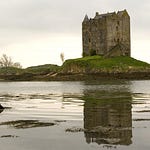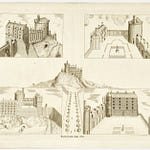Welcome back to A Scottish Castle, A Day, brought to you by BagTownClans.com. I’m your host, Colin MacDonald, and today we venture to the scenic and storied Castle Huntly. Situated on a dramatic volcanic knoll of dolerite in Perthshire, this grand fortress boasts sweeping views across the Carse of Gowrie. Rising about 50 feet above the surrounding countryside, Castle Huntly commands not only the landscape but also our imaginations, as it weaves together centuries of history, architectural evolution, and the lives of the noble families who called it home.
Castle Huntly dates back to the 15th century, with its oldest sections featuring the classic tower and jamb design typical of Scottish fortified architecture from that era. Built of sturdy Kingoodie red sandstone, the walls seamlessly blend into the volcanic rock upon which the castle stands, creating an almost organic fusion between the natural landscape and human craftsmanship. The genius of this design is evident in the way the castle appears to grow out of the very earth itself, its stone walls melding with the rugged rock face as if they were always part of the same structure.
The castle’s original keep was strategically designed for defense. As with many castles of its time, there were no accessible windows on the ground floor, and it had only one heavily fortified door. The entrance to the keep was several feet above the rock foundation, requiring either a ladder or a raised platform for entry—further evidence of its focus on security. The stonework around the castle, while not finely cut in all areas, was incredibly durable, designed to withstand attacks as well as the passage of time.
Vaulted ceilings—another hallmark of medieval Scottish architecture—were a significant feature of Castle Huntly. These robust stone ceilings were built with compressive loading in mind, ensuring they could bear the weight of upper floors without the need for timber reinforcements. This technique not only allowed for strong defensive structures but also created ample storage space in the castle’s cellars, where wine racks carved from stone still remain to this day. The cellars, with walls nearly 10 feet thick in places, were also ideal for preserving food and supplies, maintaining a cool, stable temperature year-round.
One particularly infamous part of Castle Huntly is the pit prison—a fearsome dungeon carved directly out of the rock beneath the castle. Measuring 12 by 17 feet with a 15-foot-high ceiling, this dark, dank chamber was a brutal place of confinement. The only light and ventilation came through a tiny slit high in the wall, and prisoners could only be lowered into the pit via a trapdoor from the guardroom above. Such was the grim reality of medieval justice.
Throughout its long history, Castle Huntly has undergone several significant renovations, particularly in the 17th and 18th centuries. The castle was transformed from a stark medieval stronghold into a more comfortable residence for the noble families who inhabited it. In 1660, the Earl of Strathmore, who had taken ownership of the castle, began extensive alterations. Among these changes was the addition of a new doorway on the north-east side of the castle and the development of what is now known as the Mezzanine Landing. These renovations were part of a broader trend during the post-medieval period, where defensive needs lessened, and comfort and aesthetics became more important.
By the late 18th century, the castle’s defensive features were largely obsolete. In 1776, George Paterson added Georgian wings to the north-east elevation, enhancing the castle’s grandeur and transforming it into a stately residence. A central round tower or lantern was added to the roof, raising the castle’s height to an impressive 116 feet. These architectural updates reflected the evolving needs and tastes of Scotland’s nobility during this period. Gone were the days of constant threat from invaders or rival clans, replaced by the desire for lavish, comfortable homes.
Interestingly, during these renovations in the late 1700s, workers uncovered a deep ditch filled with wood ash and other ancient materials, indicating that the site had been occupied long before Castle Huntly was built. This discovery ties the castle to a much older history, possibly reaching back to the Iron Age, when such volcanic knolls would have been natural defensive strongholds.
In the mid-20th century, Castle Huntly entered yet another phase of its long history when it passed into public ownership. For a time, it even served as a borstal—a type of youth detention center. Though this chapter is a far cry from its noble origins, it speaks to the adaptability of the structure and its continued relevance in modern times. Today, the castle is part of a national effort to preserve Scotland’s architectural heritage, ensuring that future generations can experience its rich history firsthand.
As we reflect on Castle Huntly’s five centuries of history, we see not just a castle but an evolving entity. From its 15th-century origins as a fortress, through its transformation into a grand Georgian mansion, and even its time as a correctional facility, Castle Huntly has continuously adapted to the changing needs of its inhabitants and society.
Thank you for joining us on this episode of A Scottish Castle, A Day. I hope you’ve enjoyed exploring the captivating history of Castle Huntly with me, Colin MacDonald. Be sure to tune in tomorrow as we delve into the story of yet another remarkable piece of Scotland’s castle heritage. Until next time, slán go fóill!













Share this post